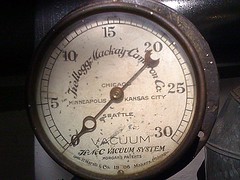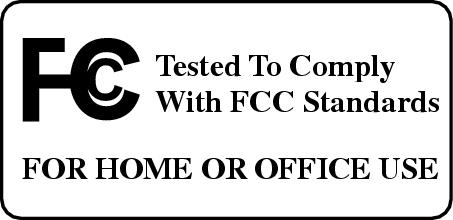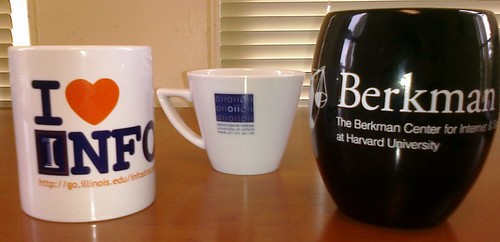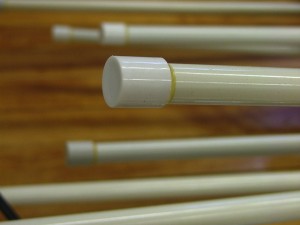When we bought our 1904 house we inherited a monster of a heating system. Steam radiators in every room, and when we moved in it didn’t work well — lots of banging, some radiators didn’t heat up at all, and the energy bill was EXPENSIVE. Worse, the temperature set on the thermostat didn’t seem connected to what happened in the house. On top of it all, this was some kind of system that none of our contractors were familiar with. They would arrive and stare at the fittings and you could see a kind of doubting look come into their faces even though they tried to conceal it. For a while we paid them to adjust things that didn’t need adjusting and add things that didn’t need to be added. The system didn’t work any better.
Finally I got down to business. By examining this antique gauge (which appears to measure a vacuum in bars of mercury) I figured out that I had a Kellogg-Mackay-Cameron Co. Vacuum System installed in 1906, based on Morgan’s patent.

(See also the flickr photoset for my heating system.)
I managed to find the original product literature [PDF] on a steam heating enthusiast web site. I found the original patent on Google Patents. Heady with this success, I thought — why not look for the original repair instructions that would be written for the steamfitters of the day? I found the book 500 Plain Answers to Direct Questions on Steam, Hot Water, Vapor, and Vacuum Heating (1915) on Google Books.
I don’t know anything about do-it-yourself projects in the home. I am not good with my hands. But no one seemed able to solve this one for me, so I dove in. After a lot of reading I ended up performing three adjustments. Two involved a screwdriver and one a wrench. That’s it. It took me two weeks to understand the system and 15 minutes to fix it. Just after I finished the last adjustment there was a terrific whooshing noise and the heat started to work — and work beautifully. It gives me a new perspective on cybernetics. The solution is never near where you see the problem. As Dan Holohan, the leading chronicler of steam heating enthusiasm, writes:
A steam system is like a child’s mobile. When you touch one part, everything else starts swaying. If you’re not sure what will happen when you touch something, don’t touch it.
My system now produces a cozy, dry heat that my allergist says is far superior to forced air. It’s much quieter. My heating bill dropped substantially (it is lower than an equivalent forced air system would be in my house, but the maintenance cost is higher for the steam system).
Like many others, I ended up with an enduring appreciation for steam. These systems were so well-made and also so clever and complex. The thought that went into a normal household heating system in 1906 boggles my mind. Dan Holohan calls his classes on these systems the Dead Men’s Steam School. (Everyone who designed these systems is dead.)

While steam radiators have a reputation for being trouble-prone heating systems, in fact the main problem is that nearly everyone that knows how to build, operate, and maintain one is dead. And what craft! My system is 100 years old and works very well. As I learned from Holohan’s writing, it is quite common to encounter parts of these systems that no one alive understands and (until recently) weren’t documented anywhere. If that knowledge were more widespread and steamfitters (and spare parts) were as common as they once were I think steam would rule the world. I guess this is another case study in path-dependence.
Pick up The Lost Art of Steam Heating and you won’t be disappointed. This book is worth buying for Dan’s chronicles of famous boiler explosions alone.






